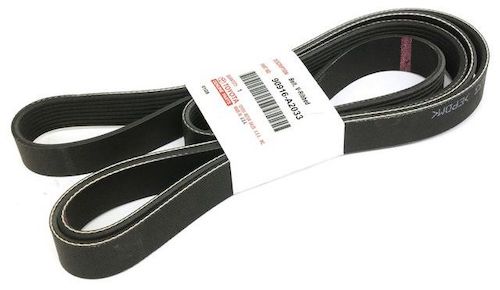Is your serpentine belt broken, and are you unsure of what to do next? Or maybe you're just curious about how these belts work? Either way, this buyer’s guide is here to help. Whether you're a seasoned DIYer or a first-time car owner, we’ll cover everything you need to know about serpentine belts, including: If you have any questions that aren’t covered here, feel free to reach out—we’re always happy to help! If you look at the side of your transversely mounted engine, you’ll likely see a long, thin belt that loops through multiple pulleys. That’s your serpentine belt, made from reinforced rubber designed to last. On conventionally mounted engines, the belt is usually found on the front. This single belt is responsible for driving several key components, such as: While it may seem like a simple part, the serpentine belt is essential. Without it, your engine would lose power to critical systems, which can lead to serious issues. For a deeper dive into how these belts work, check out our full article on the topic. If you suspect your serpentine belt is failing, it's important to address it quickly. Fortunately, diagnosing a bad belt is relatively straightforward. Start with a visual inspection—look for any signs of wear or damage, such as: If you notice any of these issues, it’s time to consider a replacement. Ignoring a faulty belt can lead to breakdowns or even engine damage, so don’t wait too long. Replacing a serpentine belt might sound complicated, but it's actually a manageable task for most DIYers. By doing it yourself, you can save a lot on labor costs. The process typically involves:
- Loosening the tensioner pulley
- Removing the old belt
- Installing the new one
With a little patience and the right tools, you can complete the job in under an hour. Follow a detailed tutorial to make sure everything goes smoothly. When it comes to choosing between OEM and aftermarket serpentine belts, there are a few key factors to consider. While aftermarket options may be cheaper, they often lack the quality and durability of OEM parts. Here's why OEM belts tend to be the better choice: For more details on why OEM belts are often the smarter investment, read our full comparison guide. DSG03-2B2 Series Direction Valves Dsg03-2B2 Series Direction Valves,Solenoid Operated Directional Control Valve,Solenoid Dc Valve,Directional Solenoid Shanghai Jinhai Hydraulic Co.,Ltd , https://www.shanghaijinhai.com
What Is A Serpentine Belt And Why Is It Important?
How To Diagnose A Bad Serpentine Belt
How To Replace A Toyota Serpentine Belt
OEM Vs. Aftermarket Toyota Serpentine Belts

Toyota Serpentine Belt Buyer's Guide